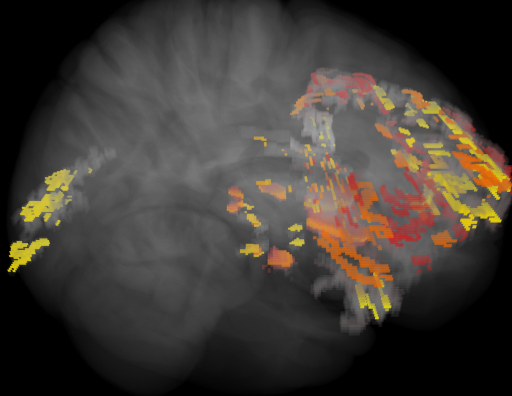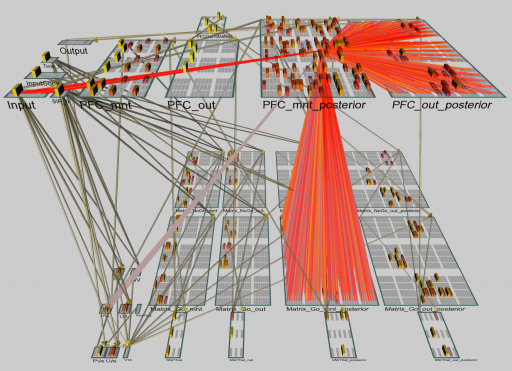A computer-like brain mechanism that makes sense of novel situations
September 26, 2013
[+]

Simulated
neural activity from the Emergent neural network software when learning
to store and recall different parts of sentences (credit: Randall
O’Reilly/University of Colorado Boulder)
[+]
Researchers at the University of Colorado Boulder have demonstrated that our brains could process new situations by relying on a method similar to the “pointer” system used by computers.
Neural
network simulation of the “indirection network” capturing a learning
episode where the simulated brain is presented with simulated words that
form sentences (credit: Randall O’Reilly/University of Colorado
Boulder)
Pointers are used to tell a computer where to look for information stored elsewhere in the system.
For the study, the research team relied on sentences with words used in unique ways to test the brain’s ability to understand the role familiar words play in a sentence even when those words are used in unfamiliar, and even nonsensical, ways.
For example, in the sentence, “I want to desk you,” we understand the word “desk” is being used as a verb even though our past experience with the word “desk” is as a noun.
“The fact that you understand that the sentence is grammatically well formed means you can process these completely novel inputs,” said Randall O’Reilly, a professor in CU-Boulder’s Department of Psychology and Neuroscience and co-author of the study.
This shows that human brains are able to understand the sentence as a structure with variables — a subject, a verb and often, an object — and that the brain can assign a wide variety of words to those variables and still understand the sentence structure.
Computers routinely complete similar tasks. In computer science, for example, a computer program could create an email form letter that has a pointer in the greeting line. The pointer would then draw the name information for each individual recipient into the greeting being sent to that person.
Location of pointer systems in the brain
In the new study, led by Trenton Kriete, a postdoctoral researcher in O’Reilly’s lab, the scientists show that the connections in the brain between the prefrontal cortex and the basal ganglia could play a similar role to the pointers used in computer science. The researchers added new information about how the connections between those two regions of the brain could work into their model.
The result was that the model could be trained to understand simple sentences using a select group of words. After the training period, the researchers fed the model new sentences using familiar words in novel ways and found that the model could still comprehend the sentence structure.
While the results show that a pointer-like system could be at play in the brain, the function is not identical to the system used in computer science, the scientists said. In the brain, for example, the pointer-like system must still be learned. The brain has to be trained, in this case, to understand sentences while a computer can be programmed to understand sentences immediately.
“As your brain learns, it gets better and better at processing these novel kinds of information,” O’Reilly said.
“The possible implications for our work are quite broad, encompassing really any situation where we may need to understand, or do, something that we previously had no exposure to,” Kriete told KurzweilAI. “By understanding the basic mechanisms that allow our brain to make sense of these new situations, we can begin to understand how we people are capable of a variety of complex cognitive abilities such as language use and analogical reasoning.”
Other study co-authors include David Noelle of the University of California, Merced, and Jonathan Cohen of Princeton University. The research was supported by an Intelligence Advanced Research Projects Activity grant through the U.S. Department of the Interior.
(¯`*• Global Source and/or more resources at http://goo.gl/zvSV7 │ www.Future-Observatory.blogspot.com and on LinkeIn Group's "Becoming Aware of the Futures" at http://goo.gl/8qKBbK │ @SciCzar │ Point of Contact: www.linkedin.com/in/AndresAgostini
 Washington
Washington